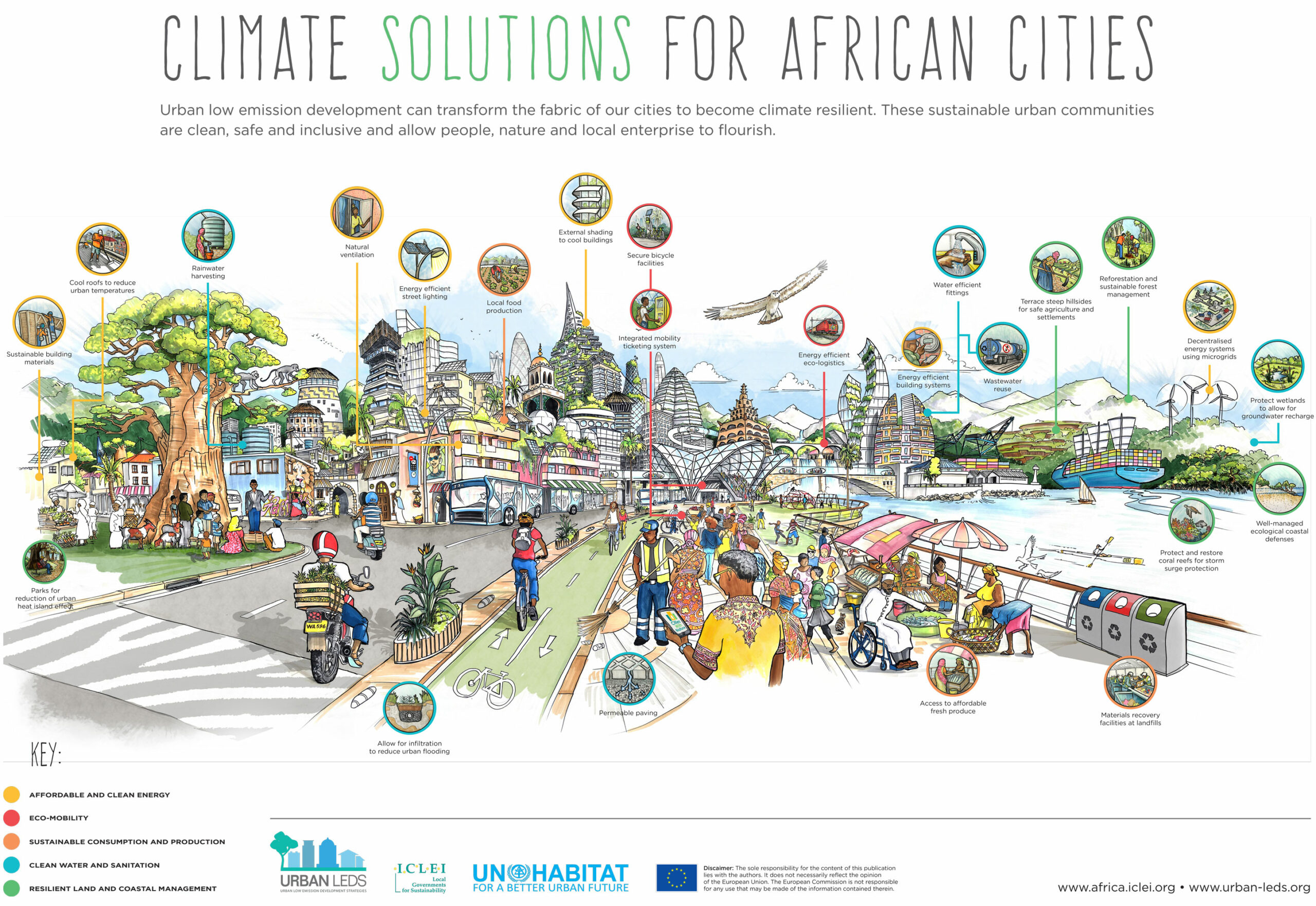Building healthy, resilient cities has never been more important. Now, more than ever, our cities need to be centres of resilience to support the health and livelihoods of all citizens. ICLEI Africa, through the Urban-LEDS II project, created this poster to both inspire and guide anyone with an interest in a thriving, resilient African city. Find the solutions that resonate most strongly with your home city and be part of the movement to transform our cities.
Click on the yellow dots on the poster below for more information

Sustainable building materials
Extracting, producing and transporting building materials relies on energy and water. Materials with lower embodied energy and water reduce dependence on natural resources significantly. Sustainable materials also contain fewer harmful chemicals, ensuring the safety of construction workers and occupants.
Cool roofs to reduce urban temperatures
To reduce heat gain on hot days, roof overhangs provide shade to windows and keep interiors cool during the midday sun.
Rainwater harvesting
By having an effective rainwater harvesting system, cities can increase water security and reduce vulnerability to flood impacts.
Natural ventilation
Being able to open windows can considerably reduce the energy consumption of buildings for cooling appliances, reduce energy bills and improve indoor environmental quality for building occupants.
Energy efficient street lighting
Street lights have an estimated 40-70% electricity saving potential if they employ energy efficient technology. This also provides savings in operational costs for the municipality.
Local food production
By 2050, 80% of food will be consumed in urban areas. Local food production can regenerate natural resources, eliminate waste and avert harmful environmental degradation from either long transport distances or unsustainable packaging.
External shading to cool buildings
Blocking the sun from reaching building surfaces without compromising natural light is more efficient than cooling the interior once the heat has entered the building. Awnings, trees or flexible devices allowing for seasonal weather changes can achieve this.
Secure bicycle facilities
Promoting more non-motorised transport corridors positively influences the safety and liveability of cities’ streets, which in turn can stimulate local business and sales tax revenues. The co-benefits are numerous, from healthier citizens (freeing up resources for state health facilities) to congestion relief.
Integrated mobility ticketing system
Allowing citizens to travel on different modes of transport with one ticket allows more people to use public transport, which reduces the use of private vehicles. Such a system enhances the ease, flexibility and efficiency of the service.
Energy efficient eco-logistics
More efficient freight and logistics can positively impact the intertwined network of private sector actors – from property development to waste management and more. Decarbonising freight could yield trillions of dollars in global economic benefits.
Energy efficient building systems
Globally, buildings account for up to 70% of a city’s electricity consumption and 40% of carbon emissions. The growth of highly efficient and net-zero new and existing buildings has huge potential in reducing costs and carbon emissions.
Water efficient fittings
Water demand management can often be significantly improved by installing fittings which prevent wasteful use of water. Existing standards and specifications can guide consumers’ choice in selecting fittings.
Wastewater reuse
Reusing wastewater can lead to huge savings, especially when high quality wastewater is reused to meet low-quality water needs. On an industrial scale, the ability to reuse wastewater makes a city far more resilient to sudden shocks in water supply.
Terrace steep hillsides for safe agriculture and settlements
Terraced hillsides are time-tested ways of both reducing erosion and surface run-off and they deliver efficient irrigation to certain crops.
Reforestation and sustainable forest management
Urban greenery and protected forests have an array of benefits, including soaking up pollution and dust, restoring ecosystems and ecosystem services, bio-sequestration of carbon emissions and a sustainable timber industry.
Decentralised energy systems using microgrids
Microgrids offer an affordable and low-carbon option for ensuring energy security. If frameworks are in place, consumers could sell excess electricity back into the grid. Where frequent blackouts occur, this offers stability for small businesses and low-income households.
Protect wetlands to allow for groundwater recharge
Extensive paving in cities prevents rainwater absorption and groundwater recharge. By having recharge points like green spaces and wetlands, stagnant water, which cannot enter the ground due to the built environment, can then be absorbed.
Well-managed ecological coastal defenses
Coastal defenses, especially in Low Elevation Coastal Zones, can play a large role in mitigating flooding and erosion. Ecological coastal defenses can protect coastal communities while simultaneously avoiding the negative flow effects often found with hard infrastructure.
Protect and restore coral reefs for storm surge protection
Coral reefs act as natural buffers, protecting shorelines from waves, storms and floods. This in turn enhances the resilience of coastal communities – their infrastructure, industry and property.
Materials recovery facilities at landfills
Recycling paper, glass, plastics, metals, e-waste and construction waste yields many benefits – from job creation and access for Small, Medium and Micro-sized Enterprises (SMMEs), to cleaner natural resources and a prosperous, circular economy.
Access to affordable fresh produce
Improving access to fresh produce enhances health equity and sustainability and addresses the imbalance of wasted food resources in consumption-heavy areas and undernutrition in others.
Permeable paving
Constructing permeable paving has a significant economic benefit in terms of combatting sewer overflows or runoff events during storms. Permeable paving slows, filters and consumes rainfall, making a city less vulnerable to flooding.
Allow for infiltration to reduce urban flooding
With greater urban expansion, the reduced space for infiltration can have degrading effects on urban soils, thereby leading to frequent flooding during rainy seasons.
Parks to reduce urban heat island effect
Urban parks can have significant cooling effects, depending on their shape and size, and the plant species they contain. They can be effective ways of disrupting the accumulated heat absorption of asphalt and associated increases in ozone production.



